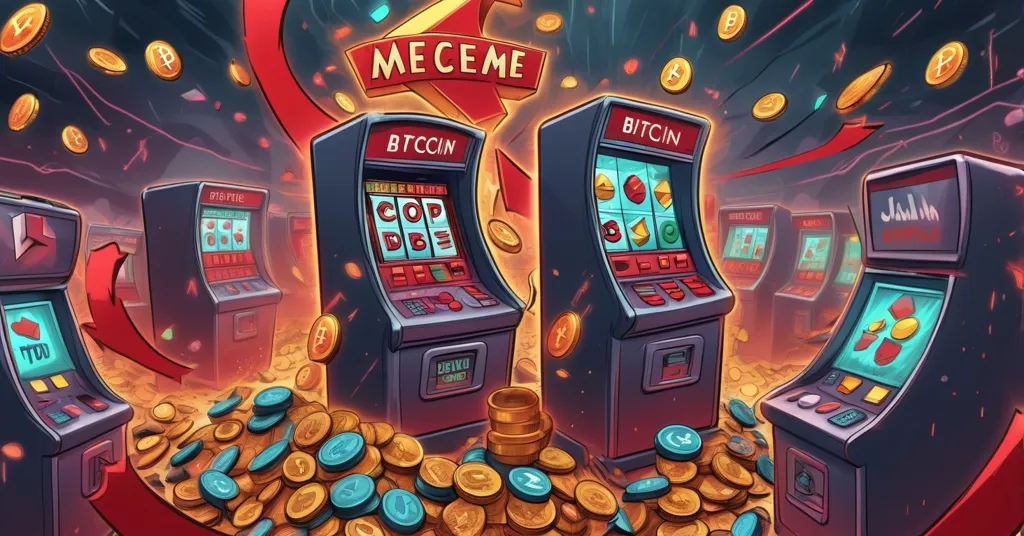PEPENODE Presale Raises $2.1M in Bitcoin Bear Market: Hype or Hazard?

PEPENODE Presale: Meme Coin Hype Amid a Bitcoin Bear Market Storm
As the crypto market bleeds out with a 3.5% drop in total cap to $3.2 trillion in just 24 hours, and Bitcoin takes a brutal 13% hit over the past week, despair hangs heavy. Yet, in this storm of red candles, a new meme coin, PEPENODE ($PEPENODE), is making waves with a presale that’s already raked in over $2.1 million. With a quirky “mine-to-earn” model and a staking APY that sounds too good to be true at 596%, is this a spark of genius or just another hype-fueled mirage waiting to vanish?
- Market Crash: Crypto market cap falls 3.5% to $3.2 trillion, Bitcoin down 13% weekly.
- PEPENODE Success: Presale raises $2.1M since September at $0.0011546 per token.
- Unique Twist: “Mine-to-earn” feature lets users build virtual rigs for meme coin rewards.
Market Meltdown: The Grim Backdrop
The crypto space is a mess right now. A 3.5% plunge in total market capitalization to $3.2 trillion signals widespread panic, and Bitcoin, the cornerstone of this ecosystem, is crumbling with a 13% weekly loss. Over the past year, it’s barely down 0.5%, but recent sentiment, partly tied to some nebulous AI-related investor jitters, has dragged it into the mud. When Bitcoin sneezes, the altcoin and meme coin sectors catch a full-blown flu. It’s carnage out there, with smaller tokens evaporating faster than you can say “rug pull.” So why, in this bear market hellscape, is something as frivolous as a meme coin like PEPENODE gaining traction? Desperation, perhaps—or the allure of a quick flip when everything else is tanking.
PEPENODE Presale: Hype in Hard Times
Launched in September, PEPENODE has defied the odds by pulling in over $2.1 million during its presale. Priced at a measly $0.0011546 per token right now, it’s a cheap bet for those chasing the next big thing. But don’t dawdle—the price jumps every three days until the presale wraps up. With a max supply of 210 billion tokens divvied up for treasury, development, marketing, rewards, and liquidity, the team claims their structure is designed to push value up over time. In crypto lingo, they call this “bullish tokenomics,” which is often more wishful thinking than hard math, especially for meme coins that thrive on viral memes, not fundamentals. Still, $2.1 million in a bear market isn’t pocket change. Is this genuine interest or just FOMO from gamblers hoping to catch the next Dogecoin?
Mine-to-Earn Madness: Innovation or Illusion?
What sets PEPENODE apart from the flood of meme coin copycats is its “mine-to-earn” gimmick. Forget dropping thousands on fancy hardware or navigating complex staking pools. Here, you use PEPENODE tokens themselves to “build” virtual mining rigs—think of it like upgrading a character in a mobile game. Spend tokens to level up your rig, and it “mines” rewards in other meme coins like Pepe and, yes, Fartcoin. We’re not kidding; Fartcoin is a real thing, and if that doesn’t scream “meme coin absurdity,” nothing does. The idea is to make mining accessible to anyone with a wallet, no tech skills needed. You buy tokens, set up your virtual rig, and watch rewards trickle in—or so the pitch goes.
But let’s pump the brakes. How exactly do you build this rig? Is it just a flashy interface on their website, or is there a deeper smart contract at play? How are rewards calculated, and where do they come from? Without a whitepaper or transparent mechanics (none are widely publicized yet), it smells like gamification to drive token sales more than genuine innovation. If you’re “mining” by spending tokens, aren’t you just buying rewards in a roundabout way? And earning Fartcoin—seriously, what’s the market for that? Until we see audits or hard details, this sounds like a clever way to say “buy more tokens,” dressed up as a feature.
Staking Promises: 596% APY Reality Check
Then there’s the staking carrot PEPENODE dangles: a mind-boggling 596% APY. For the uninitiated, APY—annual percentage yield—is how much you can earn by locking your tokens in a special account for a set time. A 596% return means a $1,000 stake could, in theory, balloon to nearly $7,000 in a year. Sounds like the deal of the century, right? Well, it’s more like a neon sign flashing “scam alert.” In legit DeFi projects, staking yields often hover between 5-20%. Anything in the triple digits, let alone quadruple, screams unsustainable. Historically, sky-high APYs are tied to token inflation or Ponzi-like schemes where early investors are paid with later ones’ money—until the music stops.
Could PEPENODE be different? Maybe, if they’ve got a magic revenue source to back those returns. But with meme coins, it’s usually just hype inflating numbers until the inevitable dump. If the token’s value crashes to zero (a real possibility), that 596% APY means squat. Proceed with eyes wide open—this isn’t passive income; it’s a high-stakes bet.
How to Join the Gamble (and Why You Might Not)
If you’re still tempted by PEPENODE’s low presale price and wild promises, getting in is simple. Head to their official website, connect a compatible wallet like Best Wallet, and buy using USDT, ETH, BNB, or even fiat currency. The price creeps up every three days, so early movers might snag a better deal before it lists on exchanges. The team hints that a listing could align with a broader market recovery, potentially sending PEPENODE to the moon. But timing the crypto market is like predicting a thunderstorm with a coin toss—good luck with that.
Here’s the harsh truth: meme coins are a casino with worse odds. They’re built on community hype and internet jokes, not utility. For every Dogecoin rags-to-riches tale, there are countless scams and dead projects. PEPENODE’s disclaimer admits the “high-risk nature of crypto investments,” which is code for “you could lose everything.” No audits, no named team, no proven track record—red flags galore. If you’re the type who’d buy a lottery ticket, that low entry price might be your kind of crazy. Just don’t bet the farm.
Meme Coin Roulette: The Bigger Picture
Zooming out, meme coins are a polarizing piece of the crypto puzzle. Stats suggest over 90% of them lose most of their value within a year, often because they’re pure speculation with no staying power. Dogecoin soared on Elon Musk’s tweets, Shiba Inu rode a hype wave, but thousands of others are digital dust. PEPENODE’s timing is gutsy—launching in a bear market takes either confidence or delusion. History shows meme coins rarely thrive in downturns; they need Bitcoin’s rising tide to lift all boats. Without a BTC rebound, even the slickest gimmick might flop.
Yet, there’s a flip side. Meme coins, for all their flaws, lower the barrier to crypto. They draw in newcomers with cheap prices and fun vibes, sometimes acting as a gateway to deeper involvement. PEPENODE’s gamified mining could, in theory, onboard curious folks who’d never touch Bitcoin’s complexity. If it sparks interest in decentralization or self-custody, that’s a win—even if the token itself fizzles. But let’s not kid ourselves: adoption shouldn’t come at the cost of burned wallets. Transparency matters, and right now, PEPENODE’s got more questions than answers.
Final Verdict: Spark or Scam?
PEPENODE is a curious blip in a brutal market. Its mine-to-earn model and 596% APY are eye-catching, no doubt, but they also scream “too good to be true.” Launching amid a Bitcoin bear market shows either bold vision or blind optimism. If the broader crypto space bounces back, a quirky token like this could ride the wave. But with zero guarantees and a laundry list of risks, it’s more likely another footnote in the meme coin graveyard. Keep your wallet locked tight unless you’re ready to kiss your funds goodbye. In this game, fun often means “funds gone.” We’re all for disrupting finance and championing decentralization, but not at the expense of basic due diligence. Show us audits, team details, and real mechanics—until then, PEPENODE’s just a shiny gamble in a sea of uncertainty.
Key Takeaways and Questions on PEPENODE and Meme Coin Hype
- What is PEPENODE, and why is it generating buzz?
PEPENODE is a new meme coin with a presale haul of over $2.1 million since September, priced at $0.0011546. Its unique “mine-to-earn” model, where users build virtual rigs to earn rewards in coins like Pepe and Fartcoin, plus a 596% staking APY, has sparked speculative interest despite a bearish market. For insights on trending meme coins, check out top meme coin picks for November. - How does PEPENODE’s mine-to-earn model work compared to traditional crypto mining?
Unlike traditional mining, which needs costly hardware, PEPENODE lets users spend tokens to create virtual rigs for rewards, making it accessible but questionable in sustainability. It’s more a gamified incentive to buy tokens than true mining, lacking clear public mechanics. - Why is a 596% APY in PEPENODE suspicious?
A 596% APY is far beyond typical DeFi yields of 5-20%, often signaling unsustainable inflation or Ponzi-like setups. Without proof of revenue to back it, such returns likely won’t last, risking a value crash for investors. - Is now a safe time for meme coin investments like PEPENODE?
With the crypto market down 3.5% to $3.2 trillion and Bitcoin sliding 13% weekly, any investment, especially in volatile meme coins, is risky. A market recovery might lift PEPENODE, but the odds of total loss are sky-high—invest only what you can afford to lose. - How can someone buy PEPENODE presale tokens, and what are the risks?
Purchase PEPENODE via its website using USDT, ETH, BNB, or fiat with a wallet like Best Wallet, noting price increases every three days. Risks are massive—meme coins are speculative, unproven, and prone to scams or hype crashes, potentially wiping out your investment. - Could PEPENODE drive crypto adoption despite the risks?
Possibly, as meme coins often attract new users with low costs and fun concepts like mine-to-earn. PEPENODE might introduce folks to crypto, but without transparency, it risks turning curiosity into costly lessons if it fails.



